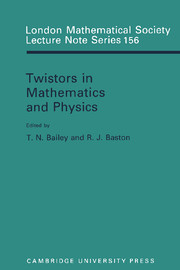Book contents
- Frontmatter
- Preface
- Contents
- 1 Twistor Theory After 25 Years—its Physical Status and Prospects
- 2 Between Integral Geometry and Twistors
- 3 Generalized Conformal Structures
- 4 Riemannian Twistor Spaces and Holonomy Groups
- 5 Twistors, Ambitwistors, and Conformal Gravity
- 6 The Penrose Transform
- 7 Notation for the Penrose Transform
- 8 The Twistor Transform
- 9 Invariant Operators
- 10 Penrose's Quasi-local Mass
- 11 The Sparling 3-form, Ashtekar Variables and Quasi-local Mass
- 12 Twistors and Strings
- 13 Integrable Systems in Twistor Theory
- 14 Twistor Characterization of Stationary Axisymmetric Solutions of Einstein's Equations
- 15 A Two-surface Encoding of Radiative Space-times
- 16 Twistors, Massless Fields and the Penrose Transform
- 17 Twistor Diagrams and Feynman Diagrams
- 18 Cohomology and Twistor Diagrams
- Authors' addresses
13 - Integrable Systems in Twistor Theory
Published online by Cambridge University Press: 05 May 2013
- Frontmatter
- Preface
- Contents
- 1 Twistor Theory After 25 Years—its Physical Status and Prospects
- 2 Between Integral Geometry and Twistors
- 3 Generalized Conformal Structures
- 4 Riemannian Twistor Spaces and Holonomy Groups
- 5 Twistors, Ambitwistors, and Conformal Gravity
- 6 The Penrose Transform
- 7 Notation for the Penrose Transform
- 8 The Twistor Transform
- 9 Invariant Operators
- 10 Penrose's Quasi-local Mass
- 11 The Sparling 3-form, Ashtekar Variables and Quasi-local Mass
- 12 Twistors and Strings
- 13 Integrable Systems in Twistor Theory
- 14 Twistor Characterization of Stationary Axisymmetric Solutions of Einstein's Equations
- 15 A Two-surface Encoding of Radiative Space-times
- 16 Twistors, Massless Fields and the Penrose Transform
- 17 Twistor Diagrams and Feynman Diagrams
- 18 Cohomology and Twistor Diagrams
- Authors' addresses
Summary
Introduction
An equation is ‘integrable’ (or ‘solvable’) if, roughly speaking, all its solutions are well-behaved and can (at least in principle) be constructed explicitly. This is a very stringent requirement: almost all non-linear equations are not integrable in this sense. For example, the Einstein vacuum equations and the Yang-Mills equations are certainly non-integrable, since one knows that they admit solutions which behave chaotically. So why bother about the (very few) equations which are integrable? Partly because it is something we can do: we search for the proverbial lost key under the lamp-post, since we have little hope of finding it anywhere else. Partly because the subject involves a great deal of very beautiful mathematics. And partly because integrable equations are relevant to the real world, in describing real phenomena such as solitons, or in serving as a first approximation to a more accurate model.
The twistor description has turned out to be particularly appropriate for many (if not all) classical integrable systems. (It has not, as yet, had much impact in the area of integrable quantum systems.) This review will attempt to show how the plethora of known integrable systems are related to one another, and how they fit into the twistor framework.
What is Integrability?
Let us begin by considering ordinary differential equations. In classical mechanics, the standard ‘Liouville’ definition of integrability is that there should exist a sufficient number of constants of motion, enabling one to reduce the equations of motion to quadratures (see, for example, [2]).
- Type
- Chapter
- Information
- Twistors in Mathematics and Physics , pp. 246 - 259Publisher: Cambridge University PressPrint publication year: 1990
- 6
- Cited by

